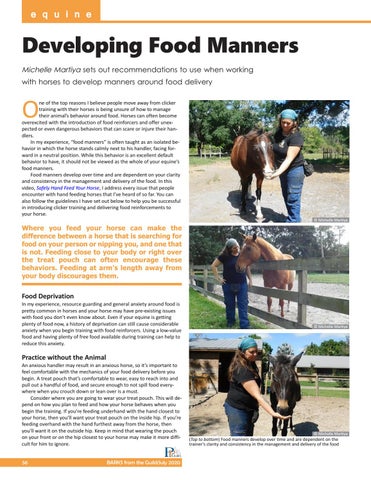e q u i n e
Developing Food Manners Michelle Martiya sets out recommendations to use when working with horses to develop manners around food delivery
O
ne of the top reasons I believe people move away from clicker training with their horses is being unsure of how to manage their animal’s behavior around food. Horses can often become overexcited with the introduction of food reinforcers and offer unex pected or even dangerous behaviors that can scare or injure their han dlers. In my experience, “food manners” is often taught as an isolated be havior in which the horse stands calmly next to his handler, facing for ward in a neutral position. While this behavior is an excellent default behavior to have, it should not be viewed as the whole of your equine’s food manners. Food manners develop over time and are dependent on your clarity and consistency in the management and delivery of the food. In this video, Safely Hand Feed Your Horse, I address every issue that people encounter with hand feeding horses that I’ve heard of so far. You can also follow the guidelines I have set out below to help you be successful in introducing clicker training and delivering food reinforcements to your horse. © Michelle Martiya
Where you feed your horse can make the difference between a horse that is searching for food on your person or nipping you, and one that is not. Feeding close to your body or right over the treat pouch can often encourage these behaviors. Feeding at arm's length away from your body discourages them.
Food Deprivation In my experience, resource guarding and general anxiety around food is pretty common in horses and your horse may have preexisting issues with food you don’t even know about. Even if your equine is getting plenty of food now, a history of deprivation can still cause considerable anxiety when you begin training with food reinforcers. Using a lowvalue food and having plenty of free food available during training can help to reduce this anxiety.
© Michelle Martiya
Practice without the Animal An anxious handler may result in an anxious horse, so it’s important to feel comfortable with the mechanics of your food delivery before you begin. A treat pouch that’s comfortable to wear, easy to reach into and pull out a handful of food, and secure enough to not spill food every where when you crouch down or lean over is a must. Consider where you are going to wear your treat pouch. This will de pend on how you plan to feed and how your horse behaves when you begin the training. If you’re feeding underhand with the hand closest to your horse, then you’ll want your treat pouch on the inside hip. If you’re feeding overhand with the hand furthest away from the horse, then you’ll want it on the outside hip. Keep in mind that wearing the pouch on your front or on the hip closest to your horse may make it more diffi cult for him to ignore.
56
BARKS from the Guild/July 2020
© Michelle Martiya
(Top to bottom) Food manners develop over time and are dependent on the trainer’s clarity and consistency in the management and delivery of the food



















